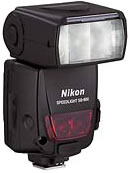Flashes |
Previous  Next Next |
Last Updated: July 26, 2010
 |
 |
 |
 |
| Nikon SB-600 AF Speedlight | Nikon SB-900 AF Speedlight | Canon Speedlite430EX II | Canon Speedlite580EX II |
| $220 | $440 | $250 | $445 |
Great Results
You'll get much better flash photos if you can bounce the flash off of the ceiling or adjacent wall. The more expensive models can twist in more directions. The pros shoot the flash straight up at the ceiling. They also fire the flash over their shoulder behind them and into the corner of the room. See this example of three kaleidoscopes (click on the photo to see the third). Buy one of these flashes. You won't regret it.
Which Model Should I Buy?
I have the Nikon SB-800 and Canon 580EX II because I wanted to light up a large room if I needed to do so. The size, weight and price were not a part of my purchasing decision. Nikon flashes only work on Nikon cameras. Canon flashes only work on Canon cameras.
| Feature | Nikon SB-600 | Nikon SB-900 | Canon 430EX II | Canon 580EX II |
| Flash head tilts up to 90 degrees? | Yes | Yes | Yes | Yes |
| Flash head tilts down 7 degrees? | No | Yes | No | Yes |
| Flash head rotates left | 180 degrees | 180 degrees | 90 degrees | 180 degrees |
| Flash head rotates right | 90 degrees | 90 degrees | 180 degrees | 180 degrees |
| Flash range (ISO 100, 35mm setting) | 98 feet | 125 feet | not stated | not stated |
| Flash range (ISO 100, 105mm setting) | Not stated | 184 feet | 141 feet | 190 feet |
| Flash coverage (24mm wide to 105mm narrow beam) | 24-85mm | 24-105mm | 24-105mm | 24-105mm |
| Minimum recycle time | 3.5 seconds | 6 seconds | 3.7 seconds | 6 seconds |
| No. flashes per set of batteries | 200 | 130 | 200 | 100 |
| Can control other flashes? | No | Yes | No | Yes |
| Advanced options, controls | Few | Many | Few | Many |
| Accessories included? | No | Yes | No | Yes |
Nikon Tip
When bouncing the flash off of the ceiling, I change my exposure compensation (EV) to +0.7 to brighten the photo using the Nikon D70s. I use the intelligent-Through The Lens (i-TTL) setting which lets the flash and the camera talk to each other. The camera expects the flash to fire straight ahead, but because the flash is fired at the ceiling, the light is diffused and the picture is darker. I use exposure compensation and the histogram to make sure the photo is properly exposed. I don't need to do this for the Canon 5D and 580EX II.
Do It Yourself Diffusers
.
Other Tips
.
Photos of flash angles:
- direct flash: 90 degrees: front view, side view
- bounce ceiling: 45 degrees: front view, side view
- bounce ceiling: 0 degrees: front view, side view
- bounce ceiling: pointing backward, camera angled down
- bounce wall: pointing left/right 90 degrees
- bounce wall: pointing left/right 45 degrees
- diffuser: portrait, landscape
Notes for future update:
- TTL is Through The Lens - camera and flash talk to each other for better exposure. Use this most of the time.
- Batteries for faster flashes. Recharge time shortened. Too many flashes too quickly will melted the flash.
- Direct flash (harsh bright spot) v. bounce flash example (natural, soft light).
- Rotate flash for different angles, including pointing backward.
- These flashes fire 3x farther than camera flashes = 100 to 125 feet - good for kids school programs.
- Flash diffuser: foam a better bounce card, video Sto-Fen Omni Bounce Gary Fong Lightsphere The Ultimate Light Box System
- Light boxes for eBay items.
- Photo Flex Lighting School
- Tip: lighting tips and technique
- Tip: Light intensity falls off by 1/4 (two stops) as the distance from the source is doubled.
- Tip: manual flash at 1/16 power for daytime photography to remove shadows around eyes. If the photo comes out too bright, then change it to 1/32 and try again.
- Tip: eliminate closed eye photos with pre-flash - Nikon D70 preflash problem - eyes closed using flash http://www.kenrockwell.com/nikon/d70flash.htm use non-TTL setting on flash custom menu setting 15: On Canon, press and hold the "*" button.
- Tip: Add +0.7 or +1.0 to the exposure compensation setting when bouncing the flash off of an 8 or 9 foot (2.5-3m) ceiling. A 20 foot (6.5m) ceiling is too high because the photos come out way too dark. Use a wall or direct flash instead.
- Tip: Strobist: Lighting 101
- Tip: When using 2 or more flashes, don't use a cable to connect the flashes so that they'll fire at the same time. The cable is expensive to buy, time consuming to make yourself, and will wear out and break sooner than expected. Use a pair of Pocket Wizards instead. They are expensive at $200 each, but they never fail.
- Tip: Change the size of the flash area from wide (24mm) to narrow (105mm) depending on what you want lit up.